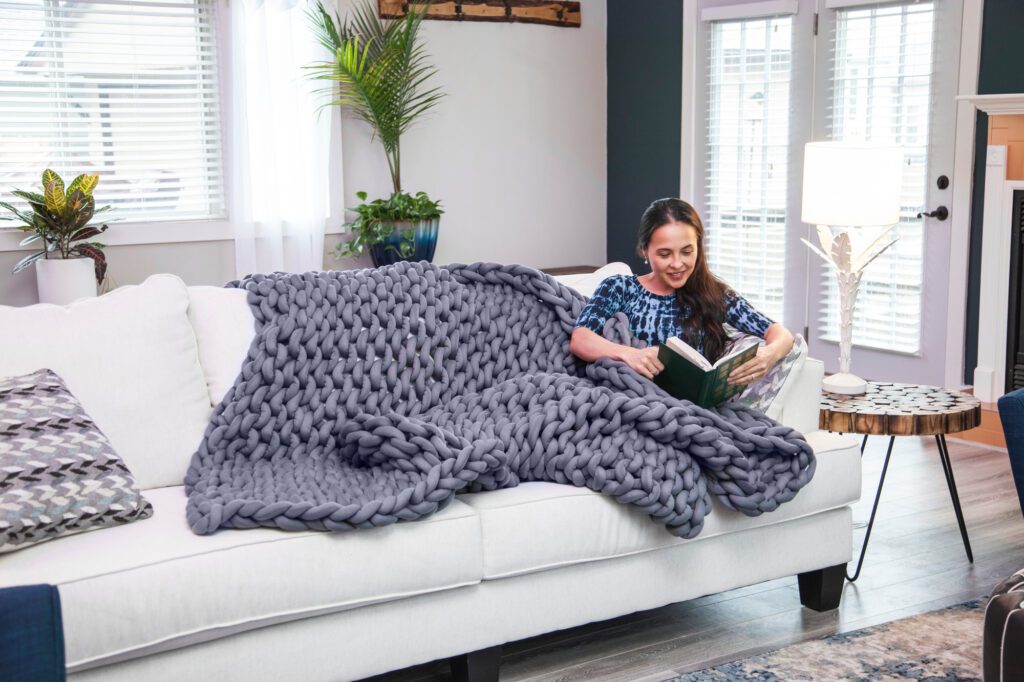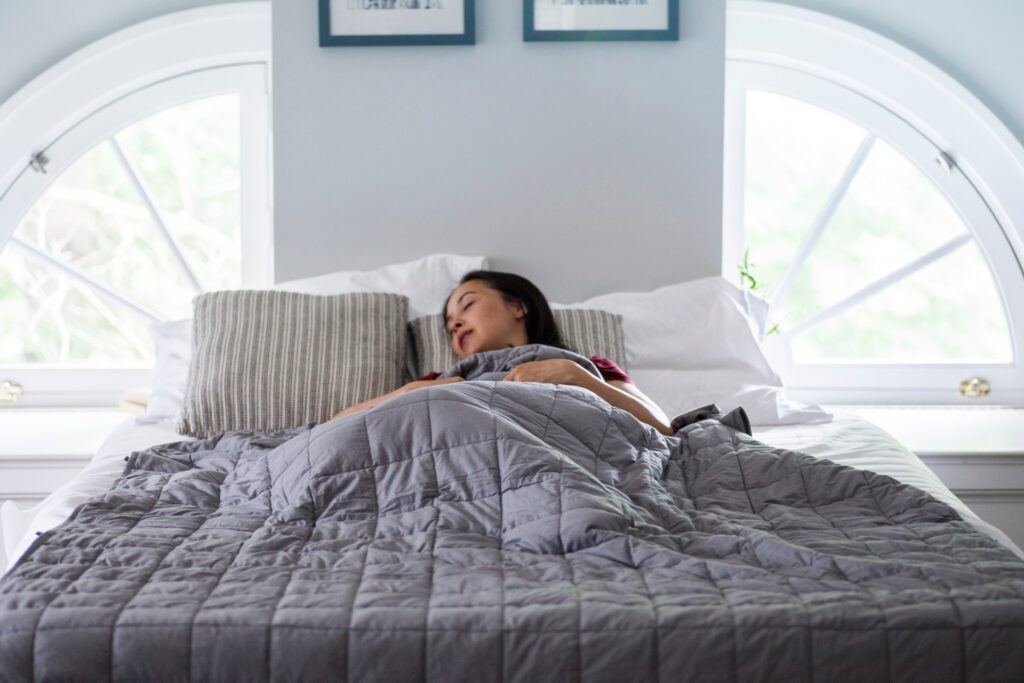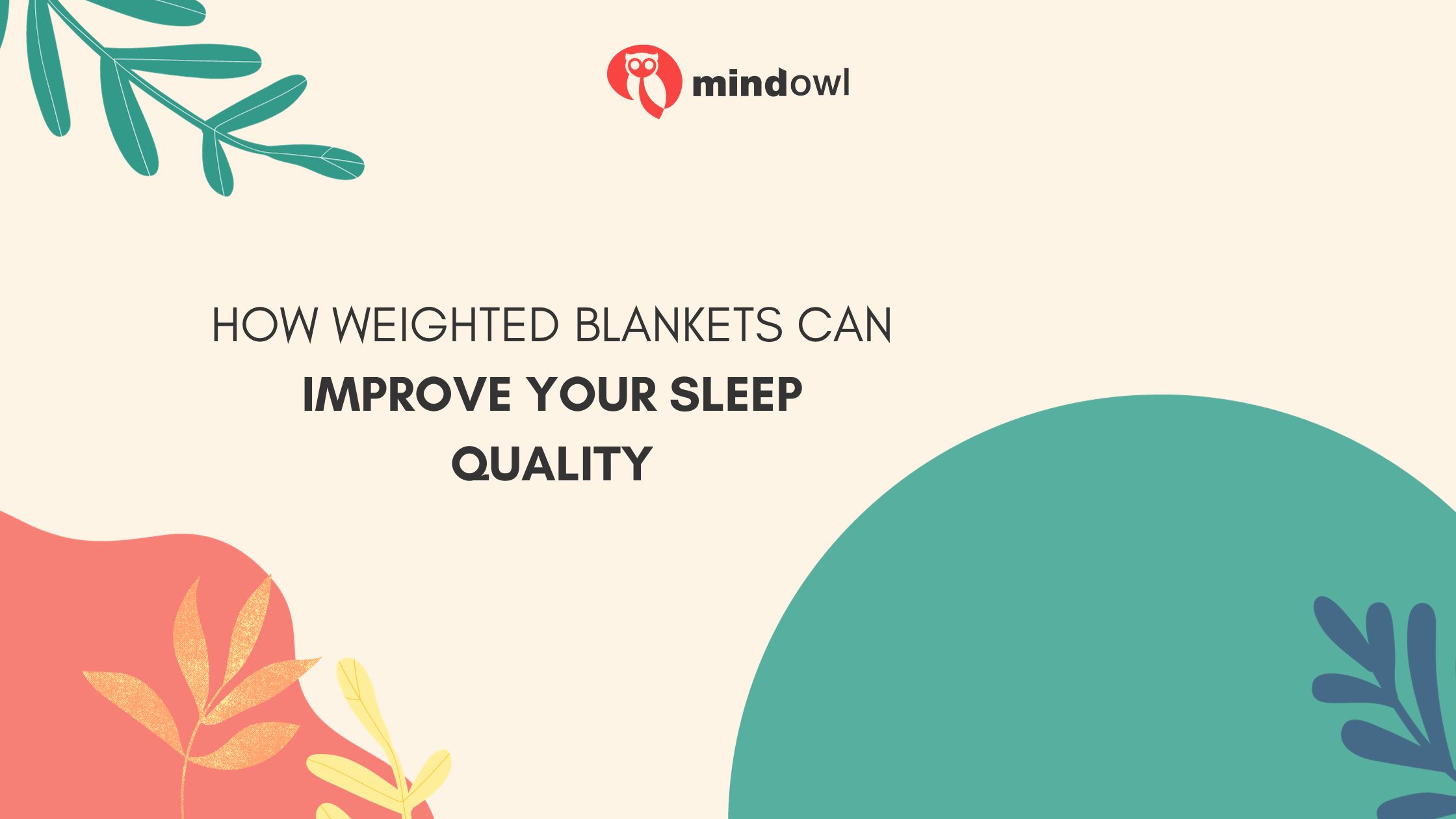A restful night’s sleep can make all the difference between a good day and a bad day. But when all your days are stressful, falling and staying asleep can be challenging. If that sounds like you, you’re not alone. About one in every three American adults report that they don’t get enough sleep every day, according to the Centers for Disease Control and Prevention. An estimated 50 to 70 million Americans have chronic, or ongoing, sleep disorders, and nearly 40 percent of adults report falling asleep during the day without meaning to at least once a month. The impact is more than just feeling tired as you go about your day. Sleep deficiency increases your risk of a wide range of physical and mental health problems, as well as injuries and loss of productivity.
Powerful prescriptions, over-the-counter medicines, and unproven herbal supplements are often recommended to help you sleep. But those can come with unwelcome side effects. What else can you do? Weighted blankets naturally improve your sleep quality without leaving you groggy in the morning. Here’s what you need to know to put the power of weighted blankets to work for you.

What is a Weighted Blanket?
A weighted blanket is an extra heavy blanket that’s designed to provide gentle, even pressure on your whole body. It is meant to mimic the sensation of being hugged, which produces a calm feeling in most people. Weighted blankets have been around for years and have commonly been used therapeutically for people with sensory processing disorders.
Weighted blankets look like ordinary bed coverings but inside the fabric is a material such as tiny glass or steel beads or plastic pellets, or natural materials such as rice or sand. The fillers are typically sewn into pockets in the fabric, so they stay evenly distributed.
The Science Behind Weighted Blankets
The calming effect of weighted blankets is based on what scientists call Deep Pressure Stimulation (DPS). Research has found that DPS, or applying gentle, steady pressure to your whole body activates the areas of the brain that manage involuntary processes such as heart rate, blood pressure and respiration, according to a report from UCLA Health. Weighted blankets have been shown in many lab and clinical studies to help people on the autism spectrum or individuals with attention-deficit hyperactivity disorder to deal with anxiety and stress.
Benefits of Sleeping with a Weighted Blanket
The most common cause of sleeplessness is daily stress. It elevates your heart rate and can keep your mind from settling down at night when you’re ready for bed. Weighted blankets soothe your nervous system so you can fall asleep. Resting under a weighted blanket also lowers your body’s levels of cortisol, the hormone that is produced when you’re under stress.
If you suffer from a more serious disorder such as chronic insomnia, sleeping under a weighted blanket can help by promoting a more relaxed, deeper sleep state. This can reduce how often you wake up during the night and improve how rested you feel in the morning.
Why Does a Weighted Blanket Help You Sleep?
The secret to the effectiveness of weighted blankets lies in their impact on the body’s nervous system. The blanket’s gentle, consistent pressure promotes an increase in your levels of serotonin and melatonin, the hormones responsible for relaxation and sleep. The UCLA report highlights a recent study in Sweden linking the use of weighted blankets to increased melatonin production. The researchers found that when a group of young adults used a weighted blanket at night, their bodies produced more melatonin than when sleeping with a conventional blanket.
Safety Considerations: Is It Safe to Sleep with a Weighted Blanket?
Weighted blankets are generally safe for healthy people. Be aware that experts caution against using weighted blankets on infants and toddlers, or someone who is not able to remove the covering on their own, such as older or frail adults. If you have asthma, sleep apnea, low blood pressure or Type 2 diabetes, consult with your healthcare providers about the safety of using a weighted blanket. Pregnant women also should ask their doctors about how weighted blankets may affect them.

How to Sleep with a Weighted Blanket
You can replace your existing bed covering with a weighted blanket or just lay it on top. For the full relaxation benefits, cover your body from your shoulders to your feet with the blanket. If you want to adjust gradually to the feeling of the blanket, try just using it over your legs for a few days. When you lie on your back, the weight is evenly distributed over your whole body, but many side sleepers find weighted blankets soothing, too.
Can You Sleep with a Weighted Blanket Every Night?
Sleeping with a weighted blanket every night is not only safe, using it consistently might amplify its benefits. Maintaining a regular bedtime routine, including the time and circumstances, leads to better sleep quality and improved overall health, according to a report in the medical journal Applied Physiology, Nutrition and Metabolism. When you use the weighted blanket each night, your body may begin to anticipate its positive effects, allowing you to drop into a deep sleep quicker.
Of course, if you’d rather not use the weighted blanket all the time, you will still get the benefits when you do. You can put it to use just when you’re especially stressed or have been suffering from periodic insomnia.
Choosing the Best Weighted Blanket for Sleep
You have a lot of options when you decide you’re ready to buy a weighted blanket. Here are some of the most important considerations:
Weight. Experts recommend that you go with one that’s about 10 percent of your body weight. You’ll see blankets that come in around 15 pounds, which are best for people weighing up to about 160 pounds. A 20-pound blanket will be better for people who weigh more.
Size. Many brands offer just one size of weighted blankets, because they work best when wrapped around one person. You can find weighted blankets designed to fit queen and king-sized beds, and models that are designed to be throw blankets you can use in bed, while you’re watching TV, or anywhere you’re in need of the calming benefits.
Fabric. Weighted blankets are frequently made of familiar materials such as cotton and knit polyester, while some brands use a fabric woven with bamboo fibers. Cotton is a classic bedding material because it’s soft and breathable, allowing air to circulate around your body as you sleep. Bamboo fibers are also soft and breathable, and they are naturally antibacterial and hypoallergenic. Lyocell, the trade name used for bamboo fabric, is the most eco-friendly option, because bamboo grows so vigorously. Another popular fabric is minky, an exceptionally plush material made from polyester fibers. If you’re a hot sleeper, look for a weighted blanket that’s made with bamboo fiber on one side and a warm material such as minky on the other.
Construction. The most effective fill material for weighted blankets is glass or steel beads because they are best suited to activate the deep pressure stimulation. These blankets also tend to be more expensive, while brands with plastic pellets can work almost as well and generally cost less. Whether you choose the beads or a blanket with rice, sand or other filler, the material should be sewn into a grid in the blanket, so the weight is evenly distributed on your body.
Care. Take note of the washing instructions for the weighted blanket options you’re considering. Some come with an outer cover that you can take off and wash with the rest of your bedding. Others may need to be handwashed to protect the inner filling.
To find the best weighted blanket for your needs, check out top-rated weighted blankets for expert evaluations and comparisons of all the brands and options you can choose from.
Conclusion
If you’d like to get more sleep and to rest more soundly, weighted blankets are a smart and safe solution. They have been shown to help many people relax, let go of stress, and drift off to sleep easily. You have a lot of choices when shopping for weighted blankets, so it’s helpful to learn about how they work, the differences in the materials used as fillers, and the options for materials and features that affect you. Ultimately, the best weighted blanket for sleep is the one that gives you the most comfort.
MindOwl Founder – My own struggles in life have led me to this path of understanding the human condition. I graduated with a bachelor’s degree in philosophy before completing a master’s degree in psychology at Regent’s University London. I then completed a postgraduate diploma in philosophical counselling before being trained in ACT (Acceptance and commitment therapy).
I’ve spent the last eight years studying the encounter of meditative practices with modern psychology.

